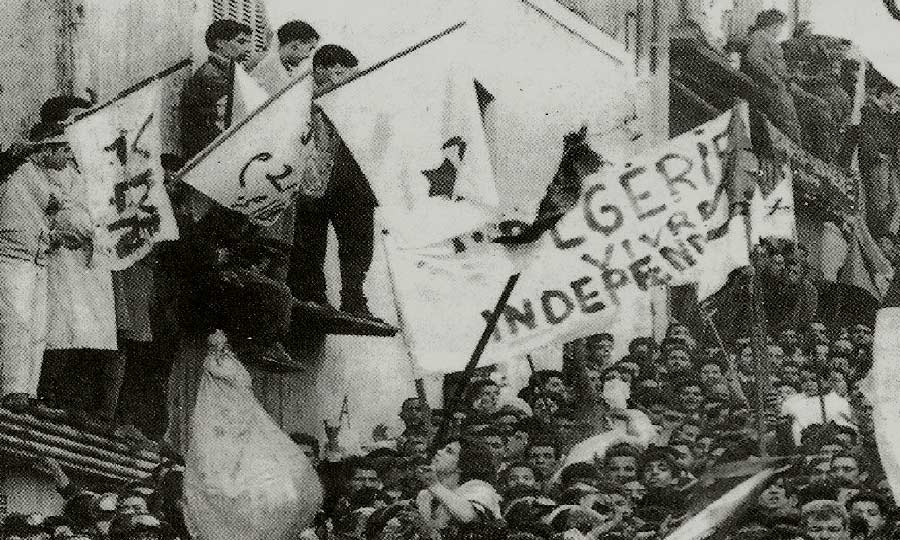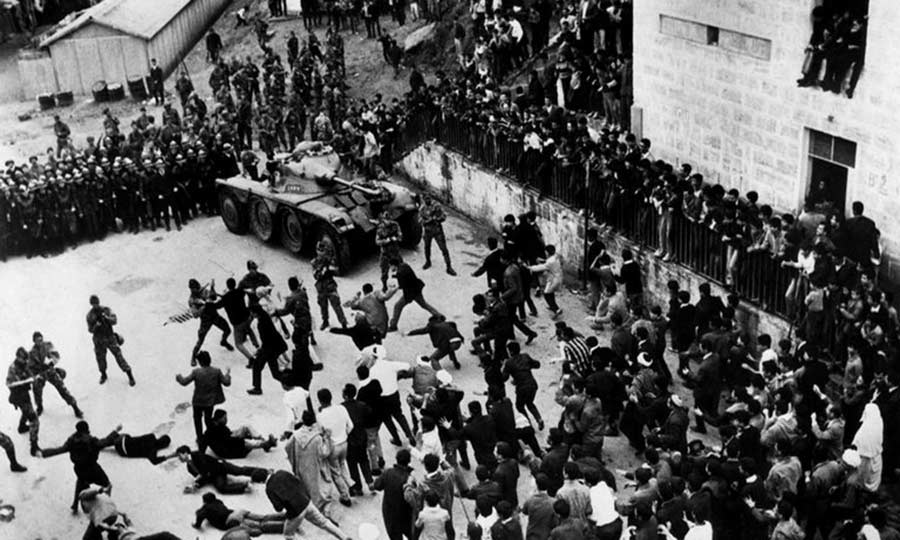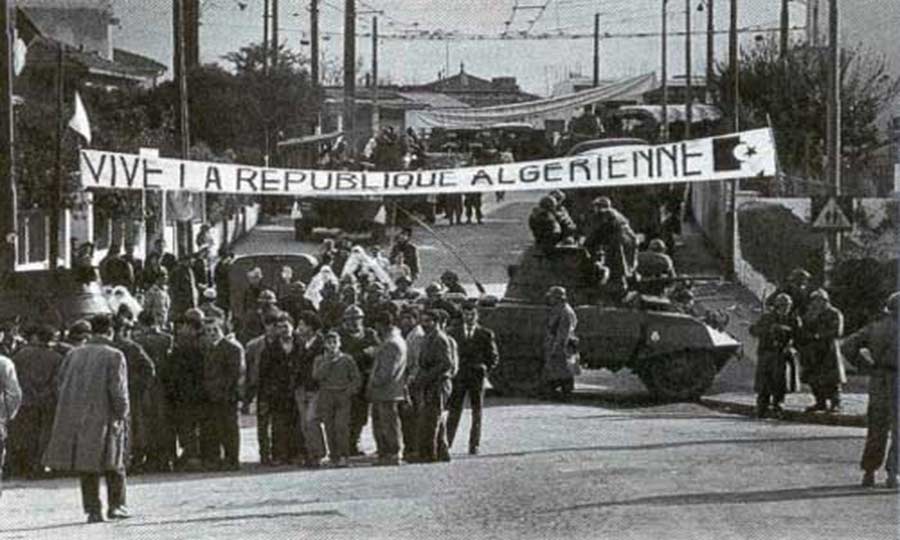Hoy se cumple un nuevo aniversario de la lucha que libró el pueblo argelino contra la ocupación francesa. La guerra de independencia de Argelia se extendió durante ocho años de masacres, torturas generalizadas, encarcelamientos a militantes por el ejército francés y un largo recorrido de resistencia del pueblo argelino por su autodeterminación y soberanía nacional que tuvo una profunda importancia para el resto de los territorios coloniales anglofranceses en África.
El Comité Revolucionario de Unión y Acción (CRUA), integrado por la alta dirigencia nacionalista y los jefes de la revolución, fundaron Argel en julio de 1954 – hoy su capital y ciudad más poblada – con la intención de unir en ese lugar a todos los grupos y tendencias independentistas para lanzarse a la lucha armada contra la ocupación. El 1 de noviembre del mismo año, el Frente de Liberación Nacional le declara la guerra a Francia.
La ocupación
Argelia fue invadida por Francia en 1830, en un momento de constante expansión territorial por parte de los países centrales en la lucha por la ocupación del mundo. La política del gobierno francés fue poblar Argelia con franceses y para 1910, ya eran 400 mil colonos en el territorio argelino. De esa manera crearon una base social que legitimó lo violento de su poder local en lo político, económico y militar.
Por más de cien años, el pueblo vivió las miserias de la ocupación, una guerra permanente escondida detrás de aquel clásico montaje de intervención pacífica. El despojo de los campesinos de sus mejores tierras y su posterior entrega a los colonos, la eliminación física de sus líderes tradicionales, el desmantelamiento del sistema educacional y la imposición de la lengua francesa en la educación son algunos de sus ejemplos.
Hasta entonces, el campesino tenía acceso a la tierra por ser miembro de una tribu o por haberla recibido en usufructo. Después de la conquista del Estado francés y de la apropiación de esas tierras, fueron brutalmente desalojados los labradores y en 1863 se instituyó el derecho a la propiedad privada individual sobre las tierras antes colectivas. Así, se destruyó de un golpe a los campesinos pobres y al complejo equilibrio entre las poblaciones sedentarias y las tribus de pastores nómades.
El germen de la lucha anticolonial
Durante la Primera Guerra Mundial, muchos argelinos participaron en el frente occidental luchando por Francia en condiciones terribles, como infantería ligera que hostigaba a otros ejércitos, o mejor dicho, como carne de cañón. A principios de la década de 1920 comenzó un nuevo movimiento contra la ocupación gala que contaba con el apoyo de intelectuales argelinos y posteriormente se fundó la “Etoile Nord-Africaine (Estrella Norte-Africana)” facción independentista que contó con el apoyo del Partido Comunista francés-argelino.
Para la Segunda guerra fueron nuevamente convocados, esta vez, para liberar la Francia ocupada por los alemanes sin que tampoco ello implique que se les reconociera autonomía alguna. En la década del ´30 se formó un movimiento compuesto por pequeños comerciantes y el campesinado en decadencia del interior, que repudiaba el destino de presupuesto para la heterogeneidad religiosa y planteaba el retorno a la pureza del Corán, la expansión del islam reformista, y creó numerosas escuelas reformistas y organizaciones de todo tipo.

Este fenómeno se combinó con la migración de los trabajadores argelinos a los suburbios de las ciudades y ambos contribuyeron a reforzar el nacionalismo. La emigración de los campesinos pobres y el traslado de los hijos de los campesinos medios para su educación en las ciudades más concentradas sirvieron para estructurar una nueva red de relaciones sociales y fomentar la organización contra Francia en medio del malestar social.
La participación de los países norafricanos en la guerra antifascista y la ocupación de Francia por Alemania en 1940 golpean el pacto colonial. Después del fin de la guerra empieza a reforzarse aquel sentimiento anticolonialista.
Las masacres de Guelma y de Sétif
El 8 de mayo de 1945, mientras Francia festejaba la derrota del nazismo, miles de argelinos se manifestaron en la ciudad de Sétif, al este del país africano, para reclamar su independencia del dominio francés.
Para la celebración se formó un cortejo de musulmanes con banderas argelinas y carteles que pedían la liberación de Messali Hadj, un dirigente y militante del nacionalismo de izquierda y también el fundador de la Estrella Norte-Africana. Cuando la policía interviene para retirarlas y es rechazada, un comisario de seguridad dispara, mata a un joven de 20 años que agitaba una de las banderas e inicia un combate brutal habilitando la dispersión de los manifestantes a fuerza de bala.
El odio de más de 100 años de subyugación colonial, de sometimiento y opresión es vengado por los argelinos con el asesinato de 102 europeos. Como medida disciplinatoria el gobierno colonial responde con 45 mil argelinos asesinados y un sistema de torturas organizadas de las que Francia reconoció su responsabilidad recién en 2008.
La guerra de independencia
El paso del tiempo fue agudizando las penurias de los argelinos, las masacres del 45 fueron la gota que rebalsó el vaso. Para alentar su olvido, De Gaulle dijo en Londres que “La sangre se seca pronto” pero estaba equivocado, renació en una resistencia que en la década siguiente fue creciendo de manera exponencial y debilitando a Francia a cada paso.
La población argelina, que fue privada de sus tierras y empujada a zonas improductivas, quedó sin sus mecanismos tradicionales de seguridad económica y sin su estructura política familiar emigró masivamente a las ciudades y recurrió a la lucha armada.
El 1 de noviembre de 1954 hubo numerosos ataques a destacamentos policiales, emboscadas, explosiones e incendios contra los colonos inaugurando la lucha armada a través de guerrillas urbanas y rurales comandadas por el Frente de Liberación Nacional que contaba en un primer momento con 500 militantes pero que rápidamente llenó sus filas ante la agudización de la represión.

Entre 1956-1957, durante la Batalla de Argel, el FLN atacó objetivos franceses y esta vez fue resistida por tropas de paracaidistas, marcando la agudización del enfrentamiento con los colonos. El general galo Jacques Massu aplicó torturas y la ejecución sumaria de miles de argelinos que militaban la causa independentista.
Los colonos franceses realizaron diversos disturbios en Argelia, en los que reclamaron la vuelta al poder del general Charles De Gaulle, quien regresó a presidir el Estado ante el peligro de una guerra civil en su país. Un nuevo levantamiento militar de los colonos se produjo en enero de 1960, aunque fracasó debido a la falta de apoyo.
El Frente de Liberación Nacional
La organización tenía un ala moderada dirigida por Ben Khedda, Mohammed Boudiaf y Hocine Ait Ahmed y un ala “socialista”, encabezada por Ben Bella, Mohammed Khider y Houari Boumedienne -Jefe del Estado Mayor del Ejército-. No todos los argelinos estaban convencidos desde la primera hora en la ruptura completa con Francia pero para 1956 el ejército francés había movilizado medio millón de soldados.
Después de la sangrienta guerra de liberación, el 18 de marzo de 1962 el gobierno francés de De Gaulle y el FLN, firmaron los Acuerdos de Evián que establecían un alto el fuego y la convocatoria de un referéndum de autodeterminación. Argelia obtuvo la independencia el 5 de julio de 1962 y tras las primeras elecciones del mes de septiembre, Ferhat Abbas fue elegido Presidente de la Asamblea Nacional Constituyente. Cerca de un millón de europeos abandonó el país, entre los que se contaban, administradores, empresarios y técnicos.

En abril de 1963, Ben Bella toma la conducción del país luego de una gran lucha por el poder, aparta a los conservadores y moldea la Constitución que será aprobada en 1963. Posteriormente se nacionalizaron las propiedades de los franceses, así como otras empresas consideradas claves en la economía del país, se resolvió la autogestión de las pequeñas y medianas empresas, se emprendió una reforma agraria y se diseñó un programa de la liberación de la mujer. Se lanzó también un plan de alfabetización y una campaña de arabización de la población que generó algunas protestas y revueltas bereberes.
Una revolución abortada
La liberación de Argelia reabre un paréntesis de euforia revolucionaria en todo el magreb, que a su vez fue inspirada y antecedida por las derrotas francesas en Dien Ben Phu, Vietnam e Indochina, debilitando a la potencia a cada momento. El PC francés, al igual que en el resto de las revoluciones de posguerra, tuvo una política de abandono a los pueblos que luchaban para liberarse del yugo de las colonias y dijo que apoyar estos movimientos era hacerle un favor al fascismo.
El FLN argelino, por las limitaciones y por su lugar en el gobierno obrero y campesino retrocedió y se limitó a la reconstrucción de un Estado burgués, contrario a los avances que ya había tenido la propia revolución. No tuvo intenciones de romper con la burguesía sino que la propia burguesía y sus partidos habían roto con ellos en una rápida alianza con la colonia francesa huyendo del país.
No se pudo hacer un frente popular porque faltaba una de las partes y por lo tanto tuvieron que avanzar más allá de sus propios límites. Así, el imperialismo francés, viendo que la revolución avanzaba le brindó concesiones, libertad democrática y cese al fuego frente a la inminente continuidad del proceso revolucionario porque no querían perderlo todo, en su lugar se construyó un Estado burgués semicolonial, dependiente del imperialismo francés y norteamericano, en lugar del Estado colonial anterior. Aquella organización estuvo al frente del gobierno y aplastó distintas movilizaciones a lo largo de la historia, como la primavera árabe en 1988 y su reedición en 2011. El pueblo argelino sigue en pie y volvió a las calles con demandas democráticas en abril del año pasado, aquel pueblo heredero de la liberación del 54 sigue en pie y volverá a luchar para recuperar lo que es suyo. El gobierno de sus propios destinos.
Colaboración de: Anabella Dalinger




